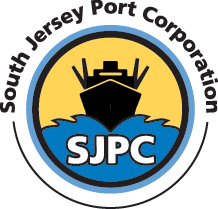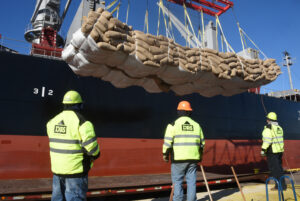For the Delaware River Stevedores (DRS) new leader Andy Sentyz, it’s a role that has deep roots in his family. “I’m a third-generation stevedore,” said Sentyz with pride. “My grandfather was a stevedore. So were four of his five sons, including my father. So, when I was 18 years old and found out that I was going to be a dad – my father told me: ‘You’re going to the docks. You’re going to work. You got a family to support.” He worked his way up through the ranks and possesses first-hand knowledge of the frontline operations of loading and unloading ships and the critical importance the stevedores’ role in the supply chain.
For families, like Sentyz’s, living in the brick rowhomes along the South Philadelphia waterfront, the docks of Camden and Philadelphia were – and still are – a place where you didn’t have to go to college – or even high school – to make good money to support your family if you were willing to work hard.
Now, at 44 years old and a quarter of a century later, the South Philly high school dropout – who earned his high school diploma, college degree and MBA while a working fulltime as a stevedore – is a grandfather and president of DRS with a staff of thirty that manages 250 union stevedores who handled a million tons of cargo last year from rolled, coiled and structural steel to plywood, cocoa beans, plywood and lumber.
He commands DRS’s operations in Camden, New Jersey; Philadelphia, Pennsylvania; and Wilmington, Delaware in a maritime world that has morphed from his grandfather’s days of the cargo hook and muscle to a more sophisticated, efficient, mechanized, and safer operation.
“We work hand-in-glove with South Jersey Port Corporation’s (SJPC) Executive Director and CEO Andy Saporito and his team,” Sentyz said. “They are our partners. They do a fantastic job bringing unique value to our mutual customers. Collectively, DRS and SJPC understand that without the customers there is no SJPC, no DRS. So, we work together in a way that makes the line between the SJPC and DRS invisible to the customer.
“We don’t win customers on price. We’re an all International Longshoremen’s Association (ILA) union operation which means we are paying living wages and benefits that comes at a higher cost. To keep a customer, we must constantly provide customers with service that exceeds the premium they are paying. We win and keep them based upon the consistent quality of our collective customer service. That means our labor partners – our ILA stevedores – and Andy Saporito and his team at the South Jersey Port and DRS work seamlessly on customer satisfaction…a happy customer is a constant customer,” Sentyz added.
Following in the footsteps of one of his mentors, recently retired DRS president Robert Palaima, it’s Sentyz’s job to lead DRS into the next generation of a constantly evolving maritime cargo business by balancing the needs of greater efficiency and productivity with safety, cargo integrity, and the conversion to “greener operations” to address the negative impacts of climate change.
Over the past 25 years, international cargo volume increasingly moved to containers for greater efficiency and the supply chain tightened as industry and manufactures slashed onsite inventory in favor of just-in-time supply. “Whatever shippers could fit into containers and do it cost-effectively, they containerized,” explained Sentyz. “Over time, supply chains meant producers didn’t need to tie up their money in warehouses filled with inventory if the supplies they need arrived on time in the production process. When the pandemic hit, this just-in-time supply chain broke. Freight rates for containers doubled, tripled, quadrupled. An extreme example is a 40-foot container from Asia through the West Coast that cost $4,000 went as high as $40,000.”
Shippers recalibrated their cargo balance and, where feasible, shifted some cargos, especially raw materials, to break bulk. “What I am hearing from many customers is that they are planning to keep at least a portion of their cargo in breakbulk so they can keep some resiliency in their supply chains so they don’t get the same sticker shock that they experienced over the last several years,” explained Sentyz. “I think the old mentality in the supply chain was to use just-in-time to drive down inventory holding costs. Now, with all the supply chain problems, people are realizing that they need to keep more inventory whether at ports or at inland facilities.”
While DRS will continue to nimbly morph to deal with the never-ending challenges of the industry, there are two immutable things that have been the hallmark of DRS’s corporate culture that will never change; focusing and prioritizing safety and customer service.
“The safety of our employees, the dock and ship crews are paramount to everything else,” said Sentyz. “There are lots of dangers flying around a marine terminal with accidents waiting to happen if you don’t adhere to safe work practices. We want our people to go home the way they came to work; safe and sound and in good health.” Sentyz speaks from experience. As a young 25-year-old crane operator, he injured his shoulder on the job. Thankfully, it wasn’t more serious but his longshoring days ended and he landed a supervisor’s job that became available. He credits his journey to leadership to DRS executives Bob Palaima and Chuck Farthing who became his mentors and encouraged him to go to college while still working and then to get an MBA – solidifying his success on the management track.
The second equally important bedrock principle of DRS is customer service. “Our business is happy customers, worker-safety, and a green, environmental-sustainable operation.”
DRS takes climate change seriously and is greening its cargo-handling fleet as fast as possible within the constraints of available green technology, terminal infrastructure to support it and an erratic supply chain on electric vehicles. “We’ll get there but the greatest obstacles right now are the supply chain, lack of charging infrastructure, sufficient electric supply, and battery capacity,” Sentyz lamented. “In the interim, we’re using the cleanest burning equipment we can as we continue down the path to lower our emissions and our operational footprint. It can take up to 84 weeks right now from order to delivery of an electric vehicle with a battery capacity for an 8-hour shift and we work 13-hour shifts at a time. It sounds daunting but evolving technology will solve the equipment issues and SJPC is working to get the electric it needs and the charging infrastructure to support greener port operations. Whether its customer service, worker-safety, or protecting this planet that we all share, we’re in a collaborative partnership to get things done.”





